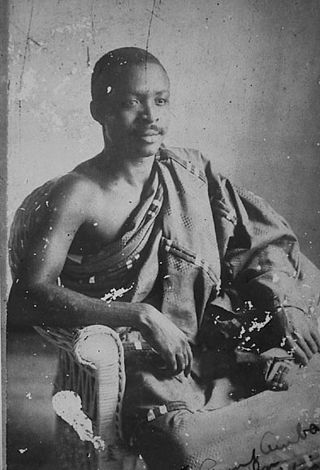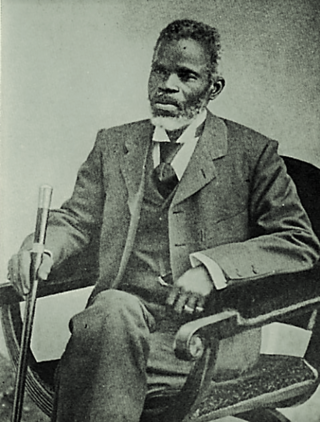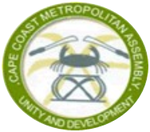
The Mfantsefo or Fante are an Akan people. The Fante people are mainly located in the Central and Western regions of Ghana, occupying the forest and coastal areas. Their land stretches from the Pra estuary in the west to the Accra borders in the east. The Fante can be broadly categorized into two groups - the Borbor Fante and the non-Borbor Fante. Over the last half century, due to fishing expeditions, Fante communities have been established as far as Gambia, Liberia and even Angola. Major Fante cities in modern Ghana include Kasoa, Winneba, Agona Swedru, Tarkwa, Oguaa, Edina (Elmina), Mankessim, Sekondi, and Takoradi.
The Fante Confederacy refers either to the alliance of the Fante states in existence at least since the sixteenth century, or it can also refer to the modern Confederation formed in 1868. The Confederation is seen as one of the first and most prominent self-rule movements in Ghana and the entirety of Africa. Its mission was to shake off colonialism and establish a modern free democratic state.

Cape Coast Castle is one of about forty "slave castles", or large commercial forts, built on the Gold Coast of West Africa by European traders. It was originally a Portuguese "feitoria" or trading post, established in 1555, which they named Cabo Corso.

The Central Region is one of the sixteen administrative regions of Ghana. It is bordered by Ashanti and Eastern regions to the north, Western region to the west, Greater Accra region to the east, and to the south by the Gulf of Guinea. The Central Region is renowned for its many elite high schools and an economy based on an abundance of industrial minerals and tourism. The Central region boasts of many tourist attractions such as castles, forts and beaches dotted along the region's coastline.

Mfantsipim is an all-boys boarding secondary school in Cape Coast, Ghana, established by the Methodist Church in 1876 to foster intellectual, moral, and spiritual growth on the then Gold Coast. Its founding name was Wesleyan High School and the first headmaster was James Picot, a French scholar, who was only 18 years old on his appointment.
John Mensah Sarbah was a prominent lawyer and political leader in the Gold Coast. He is also known as a founder of Mfantsipim School.

Joseph Ephraim Casely Hayford,, also known as Ekra-Agyeman, was a prominent Fante Gold Coast journalist, editor, author, lawyer, educator, and politician who supported pan-African nationalism. His 1911 novel Ethiopia Unbound is one of the earliest novels published in English by an African.
Articles related to Ghana include:

Anomabu, also spelled Anomabo and formerly as Annamaboe, is a town on the coast of the Mfantsiman Municipal District of the Central Region of South Ghana. Anomabu has a settlement population of 14,389 people.
Frank George Bernasko was a Ghanaian soldier, lawyer, and politician. He served as the Commissioner of Agriculture among others in the National Redemption Council (NRC) military government of General I.K. Acheampong. He was also the founder and leader of the erstwhile Action Congress Party and contested the presidential election in 1979.

William Esuman-Gwira Sekyi, better known as Kobina Sekyi, was a nationalist lawyer, politician and writer in the Gold Coast.
The Fetu Afahye is a festival celebrated by the chiefs and peoples of Cape Coast in the Central region of Ghana. The festival is celebrated on the first Saturday in the month of September every year. The Fetu Afahye is celebrated annually by the Oguaa people of Cape Coast because in the past there was an outbreak of disease among the people that killed many. The people prayed to the gods to help them to get rid of the disease. Thus the festival is celebrated to keep the town clean and to prevent another epidemic befalling the people.

Fort William is a fort in Anomabu, Central Region, Ghana, originally known as Fort Anomabo and renamed Fort William in the 1830s by its then-commander, Brodie Cruickshank, who added one storey to the main building, and renamed the fort after King William IV.

Asafo are traditional warrior groups in Akan culture, based on lineal descent. The word derives from sa, meaning war, and fo, meaning people. The traditional role of the Asafo companies was defence of the state. As the result of contact with European colonial powers on the Gold Coast, the Fante, who inhabit the coastal region, developed an especially complex version of the concept in terms of its social and political organization based on martial principles, and with elaborate traditions of visual art, including flag banners with figurative scenes, and designs alluding to historical events or proverbs.
George Emil Eminsang was a prominent Euro-African merchant and political leader on the Gold Coast, who played a prominent role in the last years of Dutch colonial rule on the Gold Coast. After the Dutch Gold Coast was transferred to the United Kingdom, Eminsang became a diplomat for the Netherlands and later for the United States and the Congo Free State. Together with James Bannerman Hyde and James Hutton Brew, Eminsang was one of the first so-called "country lawyers" on the Gold Coast.
Tourism in Ghana is regulated by the Ministry of Tourism of Ghana. This ministry is responsible for the development and promotion of tourism related activities in Ghana.

Jacob Kwaw Wilson Sey, also known as Kwaa Bonyi, was a colonial era Fante artisan, farmer, philanthropist, nationalist and the first recorded indigenous multi-millionaire on the Gold Coast. He played a major role in the Aborigines' Rights Protection Society (ARPS), founded to oppose the 1896 Crown Lands Bill and the 1897 Lands Bill that threatened the traditional land tenure system and stipulated that all unused lands be controlled by the British colonial government. The society was the 19th-century precursor which laid the foundation for the mid-20th-century "ideological warfare" pushed by the Gold Coast intelligentsia and the independence movement. Some academic scholars regard him as the "first real architect and financier towards Ghana's independence" and the ARPS as "the first attempt to institutionalize nationalist sentiment in the then Gold Coast."

Ghana–United Kingdom relations are the diplomatic, historical and trade relations between Ghana and the United Kingdom. Modern state Ghana-UK relations began when Ghana became independent from the UK in 1957.

The documented history of Elmina begins in 1482 with an agreement between the Portuguese navigator Diogo de Azambuja and the ruler of Elmina, called Caramansa by the Portuguese. In it, the Portuguese were allowed to build the first European fortress in sub-Saharan Africa. For the next 150 years until the conquest by the Dutch in 1637, Elmina was the capital of the Portuguese bases on the Gold Coast, then for about 250 years the capital of the Dutch Empire in West Africa. Since the capture of the lease for the two fortresses of Elmina by the Ashanti in 1701, the city was also important to the Ashanti Empire. Until the 19th century, Elmina was one of the most populous cities in the Gold Coast, surpassing Accra and Kumasi. The trade in gold, slaves and palm oil brought the city into direct contact with Europe, North America, Brazil and, through the recruitment of soldiers, also with Southeast Asia. It was not until the takeover and destruction of the city by the British in 1873 that Elmina lost its prominent position in the Gold Coast.

Kwadwo Egyir, later renamed Brempong Kojo and later Europeanized as Caboceer Cudjo, was born around 1700 in Ekumfi in a Fante chiefdom on the Gold Coast, the village being located in what is now the Ekumfi district of Ghana, and died on March 24, 1779, in Cape Coast. He was a slave trader in the service of the British Gold Coast in Cape Coast.






















